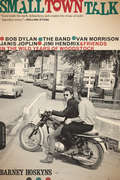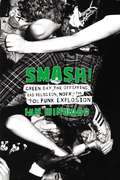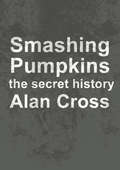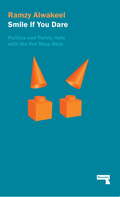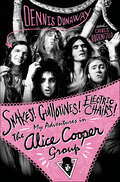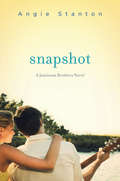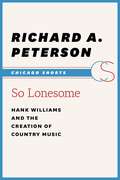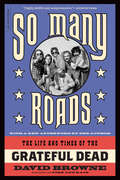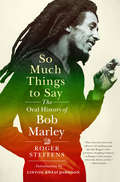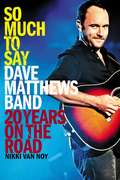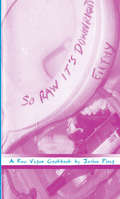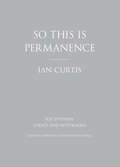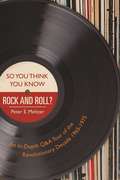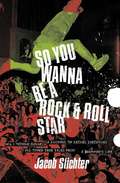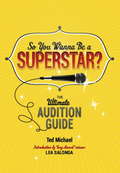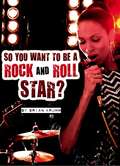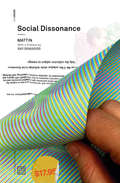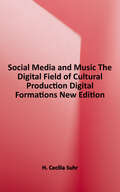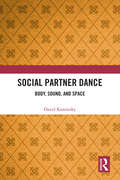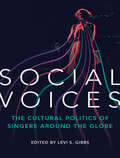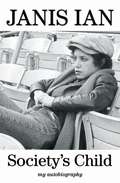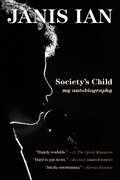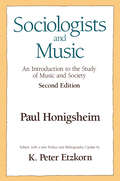- Table View
- List View
Small Town Talk: Bob Dylan, The Band, Van Morrison, Janis Joplin, Jimi Hendrix And Friends In The Wild Years Of Woodstock
by Barney HoskynsWhen musicians in the New York folk scene of the 1960s grew tired of city life, they decided to "get it together in the country. " They headed for Woodstock--not the site of the infamous music festival of 1969 but to the Catskills, to Bearsville, to Woodstock proper. Counterculture revolutionaries like Janis Joplin, Richie Havens, and Paul Butterfield got "back to the land," turning the once sleepy hollow into a funky Shangri-La. Small Town Talk tells the town’s musical history from its earliest days as a bohemian arts colony to its ongoing life as a cultural satellite of New York. Woodstock, the bucolic artists' enclave, has earned its place in rock music history; Small Town Talk is a classic study of a vital music scene in a magical place during a revolutionary time.
Smash!: Green Day, The Offspring, Bad Religion, NOFX, and the '90s Punk Explosion
by Ian WinwoodA group biography of '90s punk rock told through the prism of Green Day, The Offspring, NOFX, Rancid, Bad Religion, Social Distortion, and moreTwo decades after the Sex Pistols and the Ramones birthed punk music into the world, their artistic heirs burst onto the scene and changed the genre forever. While the punk originators remained underground favorites and were slow burns commercially, their heirs shattered commercial expectations for the genre. In 1994, Green Day and The Offspring each released their third albums, and the results were astounding. Green Day's Dookie went on to sell more than 15 million copies and The Offspring's Smash remains the all-time bestselling album released on an independent label. The times had changed, and so had the music.While many books, articles, and documentaries focus on the rise of punk in the '70s, few spend any substantial time on its resurgence in the '90s. Smash! is the first to do so, detailing the circumstances surrounding the shift in '90s music culture away from grunge and legitimizing what many first-generation punks regard as post-punk, new wave, and generally anything but true punk music.With astounding access to all the key players of the time, including members of Green Day, The Offspring, NOFX, Rancid, Bad Religion, Social Distortion, and many others, renowned music writer Ian Winwood at last gives this significant, substantive, and compelling story its due. Punk rock bands were never truly successful or indeed truly famous, and that was that--until it wasn't. Smash! is the story of how the underdogs finally won and forever altered the landscape of mainstream music.
Smashing Pumpkins: The Secret History (The\secret History Of Rock Ser.)
by Alan CrossAlan Cross is the preeminent chronicler of popular music.Here he provides a history of Billy Corgan and Smashing Pumpkins.This look at the band—"Corgan's Heroes"—is adapted from the audiobook of the same name.
Smile If You Dare: Politics and Pointy Hats With The Pet Shop Boys
by Ramzy AlwakeelA creative analysis of the band's fifth album Very, Smile If You Dare examines topics as diverse as technological paradise, sexual paranoia and representations of class in British pop music. As well as a keen critical edge, itis equipped with an undisguised mad love for the source material, a sense of passionate abandon induced by the tragic/ecstatic synth-pop that pours out of the speakers.
Smile, You're Traveling
by Henry RollinsSmile, You're Traveling is the third installment in the Black Coffee Blues series of books (which include Black Coffee Blues and Do I Come Here Often?). This time around Rollins reports from show tours and frequent flier financed travel during 1997 and 1998. Whether being terrified by roving gangs of baboons in Kenya or haggling with immigration officials over visa charges in Madagascar, Rollins finds a way to make his unique experiences universal. Says our weather beaten scribe of his journeys, "Some of it was cool, some of it was a pain in the ass, or maybe that was just me."
Snakes! Guillotines! Electric Chairs!: My Adventures in The Alice Cooper Group
by Dennis Dunaway Chris HodenfieldAs the Rock & Roll Hall of Fame says: "Before the world heard of KISS, the New York Dolls, Marilyn Manson or Ozzy Osbourne, there was Alice Cooper, the original shock-rock band."When Alice Cooper became the stuff of legend in the early '70s, their shows were monuments of fun and invention. Riding on a string of hits like "I'm 18" and "School's Out," they became America's highest-grossing act, producing four platinum albums and hitting number one on the U.S. and U.K. charts with Billion Dollar Babies in 1973. Their utterly original performance style and look, known as Shock Rock, was swiftly copied by countless bands. Dennis Dunaway, the bassist and co-songwriter for the band, tells a story just as over-the-top crazy as their (in)famous shows.As teenagers in Phoenix, Dennis Dunaway and lead singer Vince Furnier, who would later change his name to Alice Cooper, formed a hard-knuckles band that played prisons, cowboy bars and teen clubs. Their journey took them from Hollywood to the ferocious Detroit music scene, along the way adding new dimensions of rock theater. From struggling for recognition to topping the charts, the Alice Cooper group was entertaining, outrageous, and one-of-a-kind.Snakes! Guillotines! Electric Chairs! is the riveting account of the band's creation in the '60s, strange glory in the '70s, and the legendary characters they met along the way.
Snapshot: A Jamieson Brothers Novel
by Angie StantonOne kiss will change Marti's summer . . . forever. Marti Marti just wants a normal life. After dealing with her irresponsible rock-legend father and absentee mother, she only wants some peace . . . and fun. And that includes a summer at an exclusive arts camp. Adam For Adam, a normal life is not possible—not when he is the lead guitarist in a rock band with his brothers. So he's thrilled to finally have an opportunity to disguise himself and live like a normal teenager at summer camp. And when Adam meets Marti, sparks fly. Between romantic bonfires and stolen kisses, they are inseparable. Then Marti discovers who Adam truly is, and her world is turned upside down. Ever since her father nearly ruined her life, she vowed never to fall for a rocker. But when tragedy strikes, Marti is forced to look within. And she discovers that maybe falling in love with a rock star is not so crazy after all.
So Lonesome: Hank Williams and the Creation of Country Music
by Richard A. PetersonHank Williams (1923-53) was an American singer-songwriter and musician regarded as the most important country music artist of all time, creator of an unforgettable sound and persona that helped to define the genre from its infancy and beyond. Though unable to read or notate music to any substantive degree, Williams recorded 11 number one hits between 1948 and 1953, which carried him to music's mainstream and left an enduring legacy. In So Lonesome, Richard A. Peterson captures the free-wheeling entrepreneurial spirit of an era gone by, when the Grand Ole Opry put Nashville's star on the map, while detailing how Williams came to fame and helped launch country music both during his life and after his death. More than just a history of the music and one of its most celebrated performers, So Lonesome explores what it means to live an authentic life within the confines of marketing popular culture.
So Many Roads: The Life and Times of the Grateful Dead
by David BrowneThe Grateful Dead’s long, strange trip has been the subject of countless books--but none like So Many Roads. Drawing on new interviews with surviving members and people in their inner circle along with previously unknown details gleaned from the group’s extensive archives, David Browne, acclaimed music journalist and contributing editor at Rolling Stone, lends the Dead’s epic story the vivid feel of a novel. He sheds new light on the band’s beginnings, music, dynamics, and struggles since Jerry Garcia’s death in 1995. No longer dismissed as relics of the hippie era, a new generation has lionized the Dead for creating a culture that paved the way for social networking, free music swapping, and the uncompromising anti-corporate attitude of indie rock. Now, fifty years after the band first began changing rock ’n’ roll--both sonically and psychically--So Many Roads paints the most vivid portrait yet of the Grateful Dead, one of the most enduring institutions in American music and culture.
So Much Things to Say: The Oral History Of Bob Marley
by Linton Kwesi Johnson Roger SteffensA revelatory, myth-shattering history of one of the most influential musicians of all time, told in the words of those who knew him best. Roger Steffens is one of the world’s leading Bob Marley experts. He toured with the Wailers in the 1970s and was closely acquainted with Bunny Wailer, Peter Tosh and the rest of the band members. Over several decades he has interviewed more than seventy-five friends, business managers, relatives and confidants—many speaking publicly for the first time. Forty years in the making, So Much Things to Say weaves this rich testimony into a definitive telling of the life of the reggae king—the full, inside account of how a boy from the slums of Kingston, Jamaica, became a cultural icon and inspiration to millions around the world. The intimacy of the voices and the frankness of their revelations will astonish even longtime Marley fans. Readers see the intense bonds of teenage friendship among Peter, Bunny and Bob, the vibrant early sessions with the original Wailers (as witnessed by members Junior Braithwaite, Beverley Kelso and Cherry Green) and the tumultuous relationships with Rita Marley and Cindy Breakspeare. With unprecedented candor, these interviews tell dramatic, little-known stories, from the writing of some of Marley’s most beloved songs to the Wailers’ violent confrontation involving producer Lee “Scratch” Perry, Bob’s intensive musical training with star singer Johnny Nash and the harrowing assassination attempt at 56 Hope Road in Kingston, which led to Marley’s defiant performance two nights later with a bullet lodged in his arm. Readers witness Marley’s rise to international fame in London, his triumphant visit to Zimbabwe to sing for freedom fighters inspired by his anthems and the devastating moment of his collapse while jogging in New York’s Central Park. Steffens masterfully conducts the story of Marley’s last months, as Marley poignantly sings “Another One Bites the Dust” during the sound check before his final concert in Pittsburgh, followed by his tragic death at the age of thirty-six. So Much Things to Say explores major controversies, examining who actually ordered the shooting attack on Hope Road, scrutinizing claims of CIA involvement and investigating why Marley’s fatal cancer wasn’t diagnosed sooner. Featuring Steffens’s own candid photographs of Marley and his circle, this magisterial work preserves an invaluable, transformative slice of music history: the life of the legendary performer who brought reggae to the international stage.
So Much to Say: Dave Matthews Band--20 Years on the Road
by Nikki Van NoyDAVE MATTHEWS BAND has one of the largest and most loyal followings of any band today--after twenty years of constant touring and several acclaimed, multiplatinum albums, the members enjoy a connection with their fans that few other acts can match. Ask DMB devotees and they'll happily tell you tales of amazing sold-out summer shows, the stunning venues they've seen the band play all around the world, classic live show recordings . . . and memories of good times with great friends, old and new. For hundreds of thousands of people, affection for DMB goes far beyond simple fan adulation--it's a way of life. Journalist (and fan) Nikki Van Noy bridges the gap between the band and their followers, looking at the DMB phenomenon from all perspectives--including interviews with the band, Charlottesville insiders who knew them in the early days, and, of course, the DMB fans who witnessed it all. This lively, insider book offers insights into: * The beginnings of the band in Charlottesville, VA--which gave rise to the culture of taping and trading live shows, and the early online networking that laid the groundwork for their later explosive success. * The heady success of their first several albums--when the small "club" of DMB fans suddenly became a lot less exclusive. * Their creative misfires in the early 2000s--including the leaked Lillywhite Sessions. * The crushing sudden loss of saxophonist LeRoi Moore--and how the band emerged stronger than ever. A chronicle of the live Dave Matthews Band experience and what it means to be a part of it, So Much to Say is a comprehensive biography of this incredible group and the fans who helped them achieve such enduring success.
So Raw It's Downright Filthy: A Raw Vegan Cookbook (Vegan Cookbooks Ser.)
by Joshua PloegLet us not understate the might and magic of Joshua Ploeg's cooking. The dude's meals sparkle in your mouth; they burst and bloom; they explode and breakdance and pirouette! Joshua's the "traveling vegan chef" and he is-as we speak, no less!-touring the world making insane-in-the-membrane multi-course DIY meals at shows and dinner parties. (You can book him right here! http://joshuaploeg.blogspot.com/) A wonderful follow-up to his third cookbook, In Search of the Lost Taste, this brand-new zine is Joshua's take on raw food and it is llllllong awaited. Revel in the majesty of easy and cheap recipes like his Mushroom-Pear Salad with Five Spice. Give yourself a massive high five after fixin' up his pho (which is pho-king great!). Go bananas with his green curry, his incredible Shitakesbury Steak, his OMG-worthy raw Shepherd's Pie! Want some more? There's more, much more: 28 slammin' pages with tips on all-things raw, raw-related articles, and awesome-a-licious recipes like Garlic-Sunflower Pate, Cashew Sour Cream, Melon Gazpacho, and Gumbo! The raw diet does not have to mean a pile of wilted lettuce with lime squeezed over it or a handful of stinkin' peanuts! The raw diet can be a party!
So Real It Hurts
by Lydia Lunch"So Real It Hurts is the perfect title for this collection. It's a mission statement. A few bleeding slices straight from the butcher shop. A sampler from an enormous archive of work that will, no doubt, be pored over by grad students, book lovers, film historians, music nerds and straight-up perverts a hundred years from now." —Anthony Bourdain, from the IntroductionThrough personal essays and interviews, punk musician and cultural icon Lydia Lunch claws and rakes at the reader's conscience in this powerful, uninhibited feminist collection. Oscillating between provocative celebrations of her own defiant nature and nearly-tender ruminations on the debilitating effects of poverty, abuse, and environmental pollution, along with a visceral revenge fantasy against misogynistic men, Lydia Lunch presents her exploits without apology, daring the reader to judge her while she details the traumas and trials that have shaped her into the legendary figure she's become. Inserted between these biting personal essays, Lunch thoughtful cultural insights convey a widely-shared desire to forestall inevitable cultural amnesia and solidify a legacy for her predecessors and peers. Her interview with Hubert Selby Jr. and profile of Herbert Hunke, her short unromanticized histories of No Wave and of the late Sixties, and her scathing examination of the monetization of counterculture (thanks, Vivienne Westwood!) all serve to reinforce the notion that, while it may appear that there are no more heroes, we are actually just looking for heroes in the wrong places. The worthy idols of the past have been obscured by more profitable historical narratives, but Lunch challenges us to dig deeper.So Real It Hurts pulls the reader into a world that is entirely hers — one in which she exacts vengeance against predators with an enviable ease and exerts an almost-sexual dominance over authority, never permitting those with power to hold on to it too tightly.
So This is Permanence: Joy Division Lyrics and Notebooks
by Ian CurtisA treasure trove of personal writings by the great post-punk singer-songwriter—with a foreword by his wife Deborah and an introduction by Jon Savage.So This Is Permanence presents the lyrics and personal notebooks of one of the most enigmatic and influential music artists of the late twentieth century, Joy Division’s Ian Curtis.The fact of the band’s relatively few releases belies the power and enduring fascination its music holds, especially in light of Curtis’s tragic suicide in 1980 on the eve of the band’s first American tour.This volume features Curtis’s never-before-seen handwritten lyrics, accompanied by earlier drafts and previously unpublished pages from his notebooks that shed fascinating light on his writing and creative process.Also included are an insightful and moving foreword by Curtis’s widow Deborah, a substantial introduction by writer Jon Savage, and an appendix featuring books from Curtis’s library and a selection of fanzine interviews, letters, and other ephemera from his estate.
So You Think You Know Rock and Roll?: An In-Depth Q&A Tour of the Revolutionary Decade 1965–1975
by Peter E. MeltzerRolling Stone magazine recently released its list of the 100 greatest albums in rock music history, a period spanning more than fifty years. Nearly 60 percent of those albums were released in the decade from 1965 to 1975?the golden age of classic rock. This book is a wide-ranging portrait of that transformative and remarkable time, from the dawn of the singer-songwriter era to days before disco. This book is presented in a question-and-answer format, but it is hardly a ?trivia” book. It covers such diverse topics as censorship, chart phenomena, album covers, rock groupies, manufactured bands, one-hit wonders, rock festivals, supergroups, novelty songs, and the Beatles. All of the major figures of the ?60s and ?70s are here: Cream, CCR, Jimi Hendrix, Joni Mitchell, Simon and Garfunkel, the Who, the Rolling Stones, Led Zeppelin, Bruce Springsteen, Queen, Neil Young, the Eagles, the Allman Brothers, Lynyrd Skynyrd, Stevie Wonder, Elton John, Linda Ronstadt, Pink Floyd, Billy Joel, Marvin Gaye, David Bowie, James Taylor, Carole King, Aretha Franklin, Lou Reed, Carly Simon, Laura Nyro, and many others. Exhaustively researched, So You Think You Know Rock and Roll? is filled with ?I never knew that!” moments on every page.
So You Wanna Be A Rock & Roll Star
by Jacob SlichterA hilarious inside look at the real business of popular music by the drummer of Semisonic that does for rock and roll what Jim Bouton'sBall Fourdid for baseball. After years of working day jobs and making music in his basement, Jacob Slichter wondered if his dreams of rock stardom were a vain illusion. Then he was recruited by two of his successful musician friends to form a band that became Semisonic. Who could forget the smash single "Closing Time," a runaway hit in 1998 that thrust Jake and his bandmates into the international spotlight and helped them sell over two million albums worldwide? But along the road to fame and success came bewilderment and personal chaos:How will we ever get a record deal? Which record company is the best? The worst? Do I really have to wear these ridiculous boots? Why isn't radio playing our song? What if I have a panic attack right here on stage? What should I write on this fan's CD? Am I famous? Why isn't the video director getting more shots of me? Did I say the wrong thing during that interview? Help! So You Wanna Be a Rock & Roll Staris a telling and witty look at what happens just before and during one's time in the spotlight. Jake takes readers on a step-by-step journey of his evolution from fledgling drummer to globetrotting performer and proves to be the perfect guide--feistyandhumbled--to the inner workings of the music industry and instant celebrity. So You Wanna Be a Rock & Roll Starspeaks to all of us who dream again and again of rock superstardom and shows how one kid can go from picking up a pair of drumsticks to picking up a platinum record.
So You Wanna Be a Superstar?: The Ultimate Audition Guide
by Ted MichaelGeared toward hopeful musical theater, show choir, a cappella, and glee club singers, as well as all shower singers that want to improve their skills, this enthusiastic and practical guide can help anyone's inner superstardom make a public appearance. <P><P>Full of straightforward, well-organized advice for every step of the process, this book will help you train your vocal cords, pick the right audition material, and become comfortable with the spotlight. Interactive quizzes, helpful sidebars, and words of advice from industry professionals add a personalized and real-world touch. Author Ted Michael, a veteran of music and theater, along with the help of popular actors, actresses, and singers, provides all the tools young singers need in order to nail their auditions and nurture their natural show-stopping abilities.
So You Want to Be a Rock and Roll Star? (Fountas & Pinnell LLI Purple #Level T)
by Brian KrummSo You Want to be a Rock and Roll Star? by Bryan Krumm
Social Dissonance (Urbanomic / Mono #10)
by MattinAn argument that by amplifying alienation in performance, we can shift the emphasis from the sonic to the social.Work in sound studies continues to seek out sound "itself"--but, today, when the aesthetic can claim no autonomy and the agency of both artist and audience is socially constituted, why not explore the social mediation already present within our experience of the sonorous? In this work, artist, musician, performer, and theorist Mattin sets out an understanding of alienation as a constitutive part of subjectivity and as an enabling condition for exploring social dissonance--the discrepancy between our individual narcissism and our social capacity. Mattin's theoretical investigation is intertwined with documentation of a concrete experiment in the form of an instructional score (performed at documenta 14, 2017, in Athens and Kassel) which explores these conceptual connotations in practice, as players use members of the audience as instruments, who then hear themselves and reflect on their own conception and self-presentation. Social Dissonance claims that, by amplifying alienation in performance and participation in order to understand how we are constructed through various forms of mediation, we can shift the emphasis from the sonic to the social, and in doing so, discover for ourselves that social dissonance is the territory within which we already find ourselves, the condition we inhabit.
Social Media and Music: The Digital Field of Cultural Production
by H. Cecilia SuhrThis book explores social networking sites as the digital field of cultural production by loosely drawing from Pierre Bourdieu’s notion of field and capital. The book examines four case studies on MySpace, YouTube, Second Life, and Indaba Music, and the roles and the impact they have on the music industry and musicians. In doing so, the author explores the groundbreaking developments that empower independent musicians and problematizes the emergence of a variety of issues symptomatic of social media environments at the height of convergence culture.
Social Partner Dance: Body, Sound, and Space
by David KaminskySocial Partner Dance: Body, Sound, and Space is an ethnographic theory of social partner dancing built on participant observation and interviews with instructors of tango, lindy hop, salsa, blues, and various other forms. The work establishes a general analytical language for the study of these dances, based on the premise that a thorough understanding of any lead/follow form must consider in depth how it manages the four-part relationship between self, partner, music, and surroundings. Each chapter begins with a brief vignette on a distinct dance form and explores the focused worlds of partnered dancing done for the joy and entertainment of the dancers themselves. Grounded intellectually in embodiment studies and sensory ethnography, and empirically in ethnographic fieldwork, Social Partner Dance promotes scholarship that understands the social, cultural, and political functions of partner dance through its embodied practice.
Social Voices: The Cultural Politics of Singers around the Globe
by Elijah Wald John Lie Andrew Simon Kwame Dawes Nancy Guy Anthony Seeger Ruth Hellier Treva B. Lindsey Eric Lott Natalie Sarrazin Jeff Todd Titon Michael K Bourdaghs Carol Silverman Katherine Meizel Carol Muller Christina D AbreuSingers generating cultural identity from K-Pop to Beverly Sills Around the world and across time, singers and their songs stand at the crossroads of differing politics and perspectives. Levi S. Gibbs edits a collection built around the idea of listening as a political act that produces meaning. Contributors explore a wide range of issues by examining artists like Romani icon Esma Redžepova, Indian legend Lata Mangeshkar, and pop superstar Teresa Teng. Topics include gendered performances and the negotiation of race and class identities; the class-related contradictions exposed by the divide between highbrow and pop culture; links between narratives of overcoming struggle and the distinction between privileged and marginalized identities; singers’ ability to adapt to shifting notions of history, borders, gender, and memory in order to connect with listeners; how the meanings we read into a singer’s life and art build on one another; and technology’s ability to challenge our ideas about what constitutes music. Cutting-edge and original, Social Voices reveals how singers and their songs equip us to process social change and divergent opinions. Contributors: Christina D. Abreu, Michael K. Bourdaghs, Kwame Dawes, Nancy Guy, Ruth Hellier, John Lie, Treva B. Lindsey, Eric Lott, Katherine Meizel, Carol A. Muller, Natalie Sarrazin, Anthony Seeger, Carol Silverman, Andrew Simon, Jeff Todd Titon, and Elijah Wald
Society's Child: My Autobiography
by Janis IanGrammy Award-winning singer and songwriter Janis Ian's memoir of her more than forty years in the music business. Janis Ian was catapulted into the spotlight in 1966 at the age of fifteen when her soul-wrenching song "Society's Child" became a national hit. An intimate portrait of an interracial relationship, "Society's Child" climbed the charts despite the fact that many radio stations across the country refused to play it because of its controversial subject matter. But this was only the beginning of a long and illustrious career. In this fascinating memoir of her life in the music business, Ian chronicles how she did drugs with Jimi Hendrix, went shopping for Grammy clothes with Janis Joplin, and sang with Mel Torm --all the while never ceasing to create unforgettable music. In Society's Child, Ian shares with readers what it felt like to move in and out of the public eye. In 1975 her legendary song "At Seventeen" earned two Grammy awards and five nominations. But during the 1980s she made a conscious decision to walk away from the often grueling music business to study ballet and acting. She also struggled through a difficult marriage that ended with her then husband's threat to kill her. The hiatus from music lasted for nearly a decade until, in 1993, Ian returned with the release of Breaking Silence. Rather than risk losing artistic control, she took out a second mortgage on her home to fund the record. It paid off as Breaking Silencegained Ian her ninth Grammy nomination. Now in her fifth decade, Ian continues to draw large audiences around the globe. Janis Ian has inspired generations of fans and in this moving book she shares the fascinating story of her life in music.
Society's Child: My Autobiography
by Janis IanJanis Ian was catapulted into the spotlight in 1966 at the age of fifteen, when her soul-wrenching song Society's Child became a hit. An intimate portrait of an interracial relationship, Society's Child climbed the charts despite the fact that many radio stations across the country refused to play it because of its controversial subject matter. But this was only the beginning of a long and illustrious career. In this fascinating memoir of her more than forty years in the music business, Ian chronicles how she did drugs with Jimi Hendrix, went shopping for Grammy clothes with Janis Joplin, and sang with Mel Tormé all the while never ceasing to create unforgettable music. In 1975, Ian's legendary At Seventeen earned two Grammy awards and five nominations. Her next two albums brought her worldwide platinum hits. But after seven albums in as many years, she made a conscious decision to walk away from the often grueling music business. During this period, she struggled through a difficult marriage that ended with her then husband's attempt to destroy her, and a sudden illness that very nearly cost her her life. The hiatus from music lasted for close to a decade until, in 1993, Ian returned with the release of the Grammy-nominated Breaking Silence. Now, as she moves gracefully into her fifth decade as a recording artist and writer, Ian continues to draw large audiences around the globe. In Society's Child, Janis Ian provides a relentlessly honest account of the successes and failures?and the hopes and dreams?of an extraordinary life.
Sociologists and Music
by Paul HonigsheimSociologists have always been fascinated with music. In one way or another they have encountered music as an important social force in its own right, as an accompaniment or byproduct of phenomena they studied (such as youth culture or the drug scene), or as a means for obtaining social compliance (as in religious ceremonies or in the military). This book goes one step toward remedying this situation by culling the existing literature for building blocks toward introducing sociological synthesis and by presenting the English version of the extensive writings on music and society by Paul Honigsheim.
